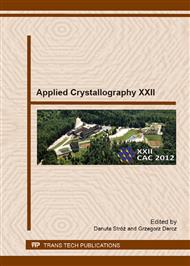p.101
p.105
p.111
p.115
p.121
p.125
p.129
p.133
p.137
Texturing of Magnetite Forming during Long-Term Operation of a Pipeline of 10CrMo9-10 Steel
Abstract:
The paper presents results of X-ray measurements of the texture of a magnetite (Fe3O4) layer formed on 10CrMo9-10 steel during 100,000 hours operation at the temperature of 575°C (in a flowing medium environment). The formed oxide layer was ≈140µm thick. Measurements of texturing were performed on the oxide surface and also at the depth of ≈50µm from the surface (1st polishing) and ≈100µm (2nd polishing). X-ray studies were carried out using the radiation of a cobalt anode tube, λCo=0.17902nm, for (311) and (400) Fe3O4 reflections, using a radiation beam collimated to φ=2mm. The study was aimed at determination of correlation between the texturing and the structure on the magnetite layer cross-section. A clear texturing of {111} and {111} type for the magnetite in the initial state and after the second polishing was found. Instead, after the first polishing there was a substantial texturing of {034} and {015} type. A different nature of the texture may result from a diversified morphology of magnetite at various depths (caused inter alia by a differentiated temperature on the tube wall cross-section during the material operation), which is related among other things to the crystallites size. The magnetite structure and texture changes can affect the magnetite porosity and cleavage.
Info:
Periodical:
Pages:
121-124
Citation:
Online since:
June 2013
Authors:
Keywords:
Price:
Сopyright:
© 2013 Trans Tech Publications Ltd. All Rights Reserved
Share:
Citation:


